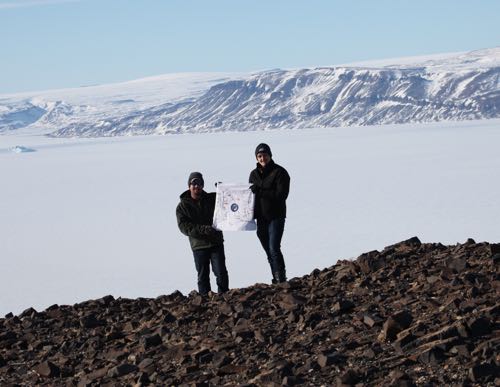Living and working on the edge of one of the only two ice sheets in this great big world is a truly humbling experience. An ice sheet is defined as a mass of glacier ice which covers an area of land greater than 50,000 square kilometers. Today I experienced what it feels like to look out over the enormous Greenland Ice Sheet from a point at which the land ice joins the sea ice.
 Taking in the spectacular view of glaciers calving into Wolstenholme Fjord.
Taking in the spectacular view of glaciers calving into Wolstenholme Fjord.
Today was an exciting day in Greenland for many reasons. I spent the better part of morning and afternoon learning and writing about Operation IceBridge's Airborne Topographic Mapper (ATM). You heard a bit about the ATM in yesterday's post on the GPS Ground System, and I am extremely excited to share with you the fundamentals behind that important tool. Please look forward to that breakdown in tomorrow's post!
By early evening, the OIB team and I took a break to head inland toward the great ice sheet and it was of course a surreal experience. Since we are stationed right on the coast the photos you have seen so far are mostly sea ice. The coastline itself is not covered in glacial ice year round, but it does not take long to reach the edge of the permanent ice sheet. Once you are at that edge you realize that as far as the eye can see into the horizon, bright white and blue glacial ice and snowpack completely dominate the landscape.
On our way to the Ice Sheet, we ran into some of the most majestic creatures of the Arctic, and I'm not talking about polar bears. A herd of musk oxen make the mountain near the Ice Sheet their home and we came across them as they were eating some of the dry vegetation growing in the mountainside.
 Musk Ox posing for a picture before heading behind the mountain at the edge of the ice sheet.
Musk Ox posing for a picture before heading behind the mountain at the edge of the ice sheet.
We finally reached our destination at a point high above the Fjord where we could see the calving fronts of at least three glaciers draining into the sea ice. The size of the icebergs that had calved off of the glaciers was deceiving from our vantage point as you'll notice in the photos that follow. How large do you think an iceberg can get? How fast do they move? Take a look at some of the photos that follow and we'll catch up on this conversation soon!
 PolarTREC Teacher stands at an overlook over Wolstenholme Fjord where four large glaciers terminate into the sea ice.
PolarTREC Teacher stands at an overlook over Wolstenholme Fjord where four large glaciers terminate into the sea ice.
 Ice bergs float in the frozen sea ice of Wolstenholme Fjord
Ice bergs float in the frozen sea ice of Wolstenholme Fjord
 A marine terminating glacier in Greenland's Wolstenholme Fjord
A marine terminating glacier in Greenland's Wolstenholme Fjord
 Kyle Krabill, Dr. Linette Boisvert, and Alek Petty take in the great view of the Greenland Ice Sheet
Kyle Krabill, Dr. Linette Boisvert, and Alek Petty take in the great view of the Greenland Ice Sheet
Question of the Day
Four large glaciers flow off of the Greenland Ice Sheet into the Wolstenholme Fjord creating icebergs as they calve. What are the names of those glaciers?
Today's Journal brought to you by Ms. Williard's 10th Grade Homeroom and Mrs. Bias's Kindergarten Class at Our Lady of Lourdes Regional School
 Sea Ice Scientists Dr. Linette Boisvert and Alek Petty represent Mrs. Bias's kindergarten class from Our Lady of Lourdes!
Sea Ice Scientists Dr. Linette Boisvert and Alek Petty represent Mrs. Bias's kindergarten class from Our Lady of Lourdes!
 ATM Engineer Kyle Krabill and Sea Ice Scientist Alek Petty represent Ms. Williard's tenth grade class from Our Lady of Lourdes!
ATM Engineer Kyle Krabill and Sea Ice Scientist Alek Petty represent Ms. Williard's tenth grade class from Our Lady of Lourdes!

Comments